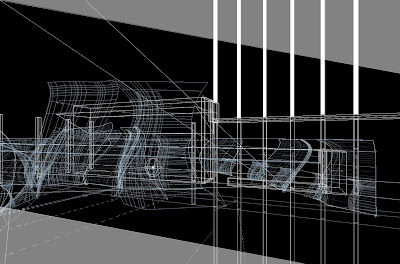Saturday, September 22, 2007
Tuesday, April 24, 2007
Monday, April 23, 2007
Sunday, April 22, 2007
Saturday, April 21, 2007
Stereotomic Permutations
So after reading the article for the fourth time this is what I got……. Preston Scott Cohen’s writings on Stereotomic Permutations attempts to develop a way by which one could view and understand an object by eliminating the boundary between description and perception. He is led to this analysis by the distortion of rational paradigmatic operations such as linearity, symmetry, scale, intersection, folding, ect… He uses the concept of parallel projection in juxtaposition to point perspective method to construct an argument that the blending of these two devices in light of the design process, would give us an architecture that’s “implicit order symmetrical order is repeatedly brought to bear on its objects and perspectives by forcing them to intersect, join, and fold back on themselves to form a series.” I find this to be an interesting investigation, but find my self speculative about the practicality and usability of the determinant results. I appreciate his conscious effort to blend that in architecture, which is descriptive with that of perception, and I found the process and graphic representation to be quite compelling.
Tuesday, April 10, 2007
Umberto Eco "Travels in Hyperreality"
Eco approaches the concept of hyper reality within the context of replication and recreation. He focuses his writings on the American Culture and out insatiable desire to "have more". The most intriguing of his conceptual agenda is the concept of blurring reproduction and "the real" to the point of indistinguishable cohabitation.
He talks about the concept of the diorama and its aim to “establish itself as a substitute for reality, as something even more real”. The concept of recreation to re present an established object ties into our current project in that we are also attempting to re present the intent of the producer, although our “diorama” is one that will take roots in its precedent but extrapolate upon previous production intentions develop into its own form.
One other concept from this reading that really ties into our projects of this term is the idea of recreating two-dimensional form with three-dimensional representation. Eco references the 20th century portrait of Peter Stuyvesant that the New York museum recreates in three-dimensional sculpture. Between, reconstructed colonial towns, wax museums, historical dioramas, and scientific advances such as the hologram and virtual reality, there is a growing fascination of the representation of time and space. This concept of hyper reality is one that will continue to grow and advance until the concept of time and space are indistinguishable.
He talks about the concept of the diorama and its aim to “establish itself as a substitute for reality, as something even more real”. The concept of recreation to re present an established object ties into our current project in that we are also attempting to re present the intent of the producer, although our “diorama” is one that will take roots in its precedent but extrapolate upon previous production intentions develop into its own form.
One other concept from this reading that really ties into our projects of this term is the idea of recreating two-dimensional form with three-dimensional representation. Eco references the 20th century portrait of Peter Stuyvesant that the New York museum recreates in three-dimensional sculpture. Between, reconstructed colonial towns, wax museums, historical dioramas, and scientific advances such as the hologram and virtual reality, there is a growing fascination of the representation of time and space. This concept of hyper reality is one that will continue to grow and advance until the concept of time and space are indistinguishable.
Subscribe to:
Comments (Atom)




